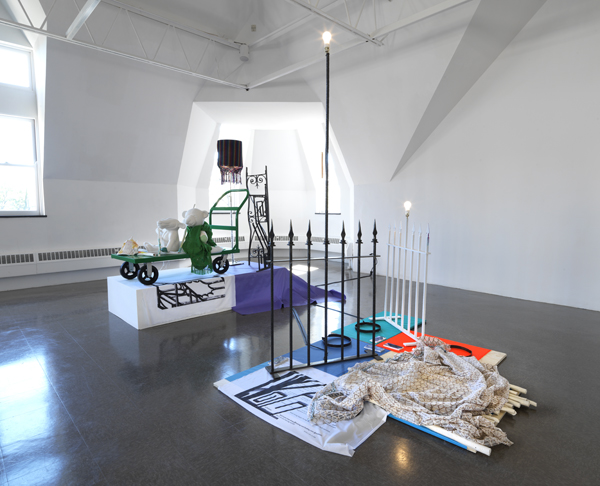A boy and a slave rafting down the Mississippi river, a night unfurling like an inky mirror of the river below it, a cottony breeze carrying the sound of chirping cicadas. The Renaissance Society’s current exhibition, “The New World, Application for Turtle Island,” by Josef Strau, conjures up such Mark Twain-like images for some, says the artist. Strau simply replaces Huck Finn with a sculpture of a white plaster wolf, Jim with a bear wrapped in an emerald scarf, and the raft with a green cart. Although this odd group is stationary, the creatures clutch paddles as if ready to meander with the guests through the maze of platform-islands guarded by other plaster wolves, bears, and turtles. Amid these islands, tall lamps stand like welcoming sentries. While the fences ringing these islands seem to create barriers between each platform, the pieces are connected by stream-of-consciousness text and patterns.
The integration of text within the constructions allows Strau to draw connections among objects, words, and images. As a result, the exhibition is organized like a book, in which the text of the historical narrative—or what Strau calls the “voice of memory”—is juxtaposed with the organization of art objects in real time. The repeating motifs of enclosures and boundaries within the exhibition, specifically the staccato of fences and disjointed white platforms that compose the base of separated, island-like assemblages, naturally call attention to themes related to immigration and entering the so-called “New World.” Strau, however, resists ascribing meaning to his work and avoids all political discussion.
“I cannot give intentions,” says Strau. “My work is about that—I avoid intentionality, but go into post-intentionality. Explaining my work is a torture because the meaning arises out of practice.” The bear and the wolf, for instance, became significant to Strau’s work only after he conceived them. Strau explains that his European colleagues in Berlin scoffed at the preliminary sketches of these plaster creatures, chuckling at their child-like quality. When Strau showed his designs to his partners in Mexico, however, they were supportive and enthusiastic about helping to produce the sculptures. In the face of the criticism from his colleagues, the sculptures gained new significance, embodying a reaction to the exclusivity of the European art scene.
“Europeans don’t appreciate the hilarity of the bear and the wolf, and they say no one wants to read text in an art exhibition,” Strau says. “When I say I want to come to America, they ask if I am a Ronald Reagan fan.”
When describing his fascination with America, Strau stresses that Europeans should be more aware that their world is not the pinnacle of culture, poetry, or the arts. While Strau believes that the artistic and intellectual circles in Europe are uninviting and distant, he notes that America’s culture has always seemed welcoming. Strau maintains, however, that these positions are purely personal. He insists that his work remain separate from overt political provocation, emphasizing that the pieces are simply an exploration of his attraction to American culture. In this way, the design of the exhibition was a subjective, reflective, and lonely process. The sculptures showcased, however, were the result of a partnership with the artists in Mexico City who created them; although initially solitary, the exhibition is ultimately collaborative. While emphasizing communication, culture, and encounters, the disjointed islands ringed by fences also hint at enclosure. While the exhibition avoids intentionality, it cannot avoid significance.
The New World, Application for Turtle Island. The Renaissance Society. 5811 S. Ellis Avenue. September 21-November 9, 2014. (773)702-8670. renaissancesociety.org

